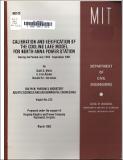| dc.description.abstract | The North Anna Power Station (3 proposed nuclear units with a total capacity of 2820MWe) is located in the State of Virginia about 41 miles northwest of Richmond. The plant condenser heat dissipation system consists of a complex geometric arrangement including a Waste Heat Treatment Facility (WHTF), consisting of a series of separate ponds with attached dead-end side arms, and Lake Anna which is a deep reservoir created by impounding the North Anna River. A segmented mathematical model was used to simulate thermal structure within the Lake Anna system. Initial model development, calibration based on pre-operational data (1977-1976), and predictions under station operation for the historical period 1957-1966 are documented in Jirka et al (1977). Since Unit 1 came on line in the Summer of 1978 and Unit 2 in Fall of 1980, an extensive data collection effort was undertaken to calibrate the model to operational data. Continuous measurements were made of meteorological variables, plant load, water temperature at various points in the system and current speeds in one of the WHTF side-arms. Supplemental data, with greater spatial resolution, were collected at weekly or monthly intervals. Calibration of the model included examination of assumptions inherent in the model development and refinement of model coefficients. Major areas of investigation included surface heat transfer processes (short wave solar radiation, long-wave atmospheric radiation and evaporation), dilution and entrance mixing, dead end side arm flow dynamics, vertical diffusion of heat below the well-mixed upper layer in the main lake, and linkage of the WHTF calculations with those of the main lake. Comparison against a three year period of operational data (1978-1981) showed that the model predictions were very accurate. An error analysis detailed explicitly the model's strengths and weaknesses, with mean surface errors (prediction-data) ranging from + 0.9 �F to-0.4 �F at four diagnostic control points and standard error ranging from 2.8 �F to 1.8 �F. Excellent agreement was also found in the vertical temperature profiles in the main lake. After verification, the model was used in a predictive mode to simulate temperatures for 1, 2 and 3 nuclear units under a range of meteorological conditions. Synthetic meteorological data had previously been prepared for the ten year period, 1957-1966, by means of a regionalization procedure. Temperature predictions for this ten year period could then be used to characterize both average and extreme conditions. During extremely warm periods (e.g., the Summer of 1959), the temperature of water released from Lake Anna to the N. Anna River downstream would have exceeded the present temperature standard of 89.6 �F (32 �C). A one-dimensional river temperature model was developed to predict downstream temperatures. Furthermore, several possibilities for reducing downstream temperatures were examined including: (i) dilution reduction in the WHTF, (ii) rerouting of the flow through the WHTF sidearms, (iii) reduction in condenser flow rate, (iv) bubble aerators in the main lake, and (v) a siphon to mix hypolimnetic cool water with warm surface water for discharge into the N. Anna River. For the siphon, which appears to be the most efficient option, simulations were performed to identify the maximum flow rate and the total volume of hypolimnetic water withdrawn, in order to comply with downstream temperature standards in each of the ten years simulated. | en_US |
